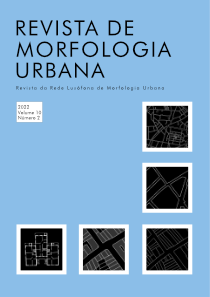Abstract
The urban environment has been recognized as one of the main scenarios for the spread and spread of contagious diseases caused by viruses, such as SARS-CoV-2, which causes COVID-19. Contagion occurs through contact between people. Since 2020, the WHO has declared COVID-19 a pandemic, which has had major social implications and impacts on health, the economy and work. To understand the relationship between the spread of the disease and its spatial relationships, a case study was carried out in the city of Coronel Fabriciano, Minas Gerais, Brazil, in which the Spatial Syntax methodology was applied, specifically the integration and choice measures, correlating the product of this analysis with Kernel density maps, the result of a mapping of 7,751 confirmed cases of the disease between March 2020 and March 2022, and with socioeconomic and infrastructure variables. The results of this study showed a strong relationship between the spatial configuration and the spread of COVID-19 cases, which may lead to the proposition of guidelines to combat epidemics that aim to cause less socioeconomic damage, such as, for example, a more flexible confinement.
References
Câmara Municipal, Coronel Fabriciano. (2021) “História do Município de Coronel Fabriciano”. Acesso em: Agosto de 2022. Disponível em: https://www.coronelfabriciano.mg.leg.br/institucional/historia
Gatrell, A. C. et al.(1995) “The geographical epidemiology of ocular diseases: some principles and methods”. Eye, v. 9, n. 3, p. 358-364.
Hanson, Julienne. (1998) Decoding homes and houses.
Heitor, Teresa. Pinelo-Silva, João(2015). “A Sintaxe Espacial e o Ambiente Construído–Análise Morfológica”. O Estudo da Forma Urbana em Portugal. Universidade do Porto Edições. Porto.
Hillier, Bill. (1996) “Space is the machine: a configurational theory of architecture”. Space Syntax.
Hillier, Bill; Hanson, Julienne. (1989) “The social logic of space”. Cambridge university press.
Hillier, Bill; Netto, Vinicius. Society seen through the prism of space: outline of a theory of society and space. 2001.
IBGE, Censo. Instituto Brasileiro de Geografia e Estatística-IBGE. (2010) “Censo Demográfico”: Cidades e estados, Coronel Fabriciano. Acesso em: Agosto de 2022. Disponível em: https://www.ibge.gov.br/cidades-e-estados/mg/coronel-fabriciano.html
Prefeitura, Coronel Fabriciano. (2022) História. Acesso em: Agosto de 2022. Disponível em: https://www.fabriciano.mg.gov.br/historia.
Vaz, D. dos S.; Vaz, J. S. (2009 “Análise geográfica dos eixos de desenvolvimento de Coronel Fabriciano (MG)” / Geographical Analysis Of Development Axles Of Coronel Fabriciano (MG). Caminhos de Geografia, [S. l.], v. 9, n. 28. Acesso: Agosto de 2022. Disponível em: https://seer.ufu.br/index.php/caminhosdegeografia/article/view/15777.

This work is licensed under a Creative Commons Attribution 4.0 International License.
Copyright (c) 2022 Arthur Oliveira, Vanessa Beraldo Machado, Gustavo Soares Silva, Laura Duarte Pereira Lopes, Lívia Maria Alvarenga Santos, Giovanna Domingues Mendes Gonçalves, Maria Fernanda Souza Silva

